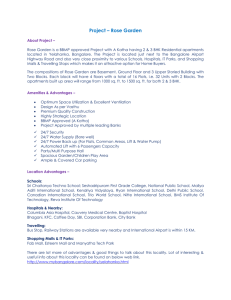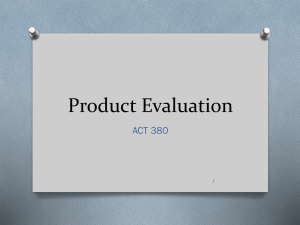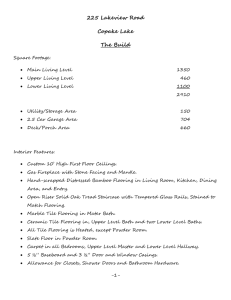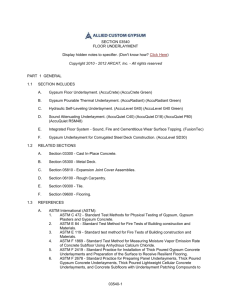ritz flooring lvt installation instructions
advertisement
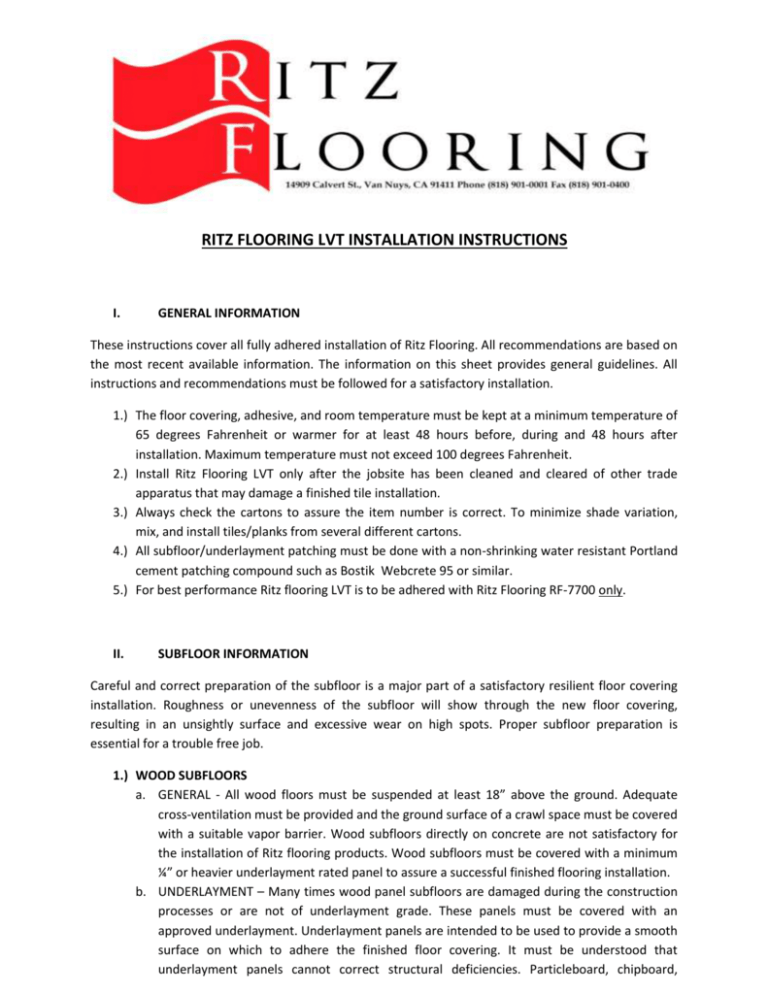
RITZ FLOORING LVT INSTALLATION INSTRUCTIONS I. GENERAL INFORMATION These instructions cover all fully adhered installation of Ritz Flooring. All recommendations are based on the most recent available information. The information on this sheet provides general guidelines. All instructions and recommendations must be followed for a satisfactory installation. 1.) The floor covering, adhesive, and room temperature must be kept at a minimum temperature of 65 degrees Fahrenheit or warmer for at least 48 hours before, during and 48 hours after installation. Maximum temperature must not exceed 100 degrees Fahrenheit. 2.) Install Ritz Flooring LVT only after the jobsite has been cleaned and cleared of other trade apparatus that may damage a finished tile installation. 3.) Always check the cartons to assure the item number is correct. To minimize shade variation, mix, and install tiles/planks from several different cartons. 4.) All subfloor/underlayment patching must be done with a non-shrinking water resistant Portland cement patching compound such as Bostik Webcrete 95 or similar. 5.) For best performance Ritz flooring LVT is to be adhered with Ritz Flooring RF-7700 only. II. SUBFLOOR INFORMATION Careful and correct preparation of the subfloor is a major part of a satisfactory resilient floor covering installation. Roughness or unevenness of the subfloor will show through the new floor covering, resulting in an unsightly surface and excessive wear on high spots. Proper subfloor preparation is essential for a trouble free job. 1.) WOOD SUBFLOORS a. GENERAL - All wood floors must be suspended at least 18” above the ground. Adequate cross-ventilation must be provided and the ground surface of a crawl space must be covered with a suitable vapor barrier. Wood subfloors directly on concrete are not satisfactory for the installation of Ritz flooring products. Wood subfloors must be covered with a minimum ¼” or heavier underlayment rated panel to assure a successful finished flooring installation. b. UNDERLAYMENT – Many times wood panel subfloors are damaged during the construction processes or are not of underlayment grade. These panels must be covered with an approved underlayment. Underlayment panels are intended to be used to provide a smooth surface on which to adhere the finished floor covering. It must be understood that underlayment panels cannot correct structural deficiencies. Particleboard, chipboard, construction grade plywood, any hardboard and flake board are not recommended as underlayment for fully adhered installations. All have inadequate uniformity, poor dimensional stability, and variable surface porosity. Ritz Flooring will not accept responsibility for adhered installation over these subfloors. In all cases, the underlayment manufacturer or underlayment installer is responsible for all underlayment warranties. c.) UNDERLAYMENT REQUIREMENTS – Panels intended to be used as underlayment should be specifically designed for this purpose. These panels should have a minimum thickness of ¼”. Any panels selected as an underlayment must meet the following criteria: Be dimensionally stable Have a smooth, fully sanded face so the graining or texturing will not show through Be resistant to both static and impact indentation Be free of any surface components that may cause staining such as plastic fillers, marking inks, sealers, etc. Have a written warranty for suitability and performance from the panel manufacturer or have the history of proven performance. Any unevenness at joints between panels must be sanded to a level surface. Gaps between panels, hammer indentations, and all other surface irregularities must be patched with Bostik Webcrete 95. 2.) CONCRETE SUBFLOORS a.) Concrete subfloors must be dry, smooth, and free from dust, solvent, paint, wax, grease, oil asphalt, sealing compounds and other extraneous materials. The surface must be hard and dense, and free from powder or flaking. b.) New concrete slabs must be thoroughly dry and completely cured (at least six weeks). Curing agents, surface hardeners and other additives may cause adhesive bonding failure. These should be removed by sanding or grinding. c.) All concrete slabs must be checked for moisture before installing material. Calcium Chloride tests conducted according to ASTM F 1869 and/or In Situ Relative humidity tests as conducted according to ASTM F 2170 are the most commonly accepted test procedure. It is recommended not to install Ritz Flooring LVT over concrete slabs with a history of excessive moisture or hydrostatic conditions. Concrete subfloors that exceed 8 lbs MVER as determined with the Calcium Chloride test (ADTM F-1869) or 95% RH as determined by the Relative Humidity test (ASTM F 2170) should be considered excessive with regards to moisture emissions. Excessive moisture vapor emissions may contribute to an unhealthy indoor environment and can be a major contributor to failing installation. Ritz Flooring will not assume responsibility for floor covering failure due to hydrostatic pressure or moisture vapor emission. The final responsibility for determining if the concrete is dry enough for installation of the flooring lies with the floor covering installer. d.) Holes, grooves, expansion joints and other depressions must be filled with Bostik Webcrete 95 patching and leveling compound (or equivalent), and trowelled smooth and feathered even with the surrounding surface. e.) Concrete floors with a radiant heating system are satisfactory, provided the temperature of the concrete floor does not exceed 90 degrees Fahrenheit at any point. Before installing the flooring, the heating system should be turned on to eliminate residual moisture. 3.) EXISTING RESILIENT FLOOR COVERINGS - To achieve maximum product performance, fully adhered Ritz Flooring LVT should not be installed over existing resilient floor coverings. In the rare cases where removal of the existing resilient floor covering is not an option, the existing flooring must be covered with Bostik’s Webcrete 95 used as an Embossing Leveler or other appropriate porous underlayment. Warning: Do not stand, dry scrape, bead blast or mechanically pulverize existing resilient flooring, backing or lining felt. These products may contain asbestos fibers that are not readily identifiable. Using the above non-recommended procedures on asbestos-containing material can create asbestos dust. The inhalation of asbestos dust may cause asbestos or other serious bodily harm. Smoking greatly increases the risk of serious bodily harm. Smoking greatly increases the risk of serious bodily harm. Ceramic tiles should be made smooth by applying a cement based overlay such as patching or leveling compound. When the removal of the existing resilient floor covering is not an option, the existing flooring must be covered with Webcrete as an Embossing Leveler or equivalent. Existing vinyl floors should not be heavily cushioned and consist of one layer only. III. INSTALLATION: 1.) As with all tile formats, tiles should be balanced on the work area. Tiles may be laid squarely in the work area or laid out diagonally in the work area. In either case, the room must be accurately measured to square off the area and to determine the center point of the area and to determine the center point of the area the work area should be divided into quadrants designated by striking chalk lines. It is critical that the intersection of the chalk lines be square at 90 degrees. All border tiles should be of nearly equal dimensions and at least one-half of a tile wide. Careful and precise measurements must be taken during tile layout. Adjust this established line to accommodate a balanced layout and then transpose this line to a comfortable width away from the staring wall (approximately 2’ to 3’ wide). Apply the adhesive in this area and begin installing the tiles. Lay all tiles in the same direction, all directional arrows pointing in the same direction. 2.) It is also important to balance the layout of the plank format. Proper planning and layout will prevent narrow plank widths at wall junctures. Determine layout to prevent having less than ½ plank width or very short length pieces. As with all plank products, lay the long dimension of the plank parallel to the long dimension of the work area. Accurately measure the room to determine the center line, adjust this established line to accommodate a balanced layout and then transpose this like to a comfortable width away from the starting wall (approximately 2’ to 3’ wide). Apply the adhesive in this area and begin installing planks. Lay all planks in the same direction, all directional arrows pointing in the same direction. 3.) Adhesive Application – Ritz Flooring RF-7700 adhesive is required for adhering Ritz Flooring LVT. For assurance squared, apply the RF-7700 with a 1/16” wide, 1/32” deep, 1/32” apart notched trowel. Begin applying adhesive at the pre-determined chalk lines working in two to three foot increments working towards an exit of the room. The RF-7700 has a 30 to 60 minutes working time. Do not apply more adhesive than can be covered in this time. Set Ritz Flooring LVT into the dry to the touch adhesive and never work directly on top of the freshly installed product. Roll each installed section of flooring with a three-section 100 pound floor roller. 4.) Tile & Plank Installation – Use the “dry-set” method which means that the tiles and planks be installed from a wall working backwards towards an exit. Move the established lines to within 2’ to 3’ of the starting wall and apply the RF-7700 adhesive. Set the tile into the adhesive; do not slide tiles/planks into place. Thoroughly roll each section of installed product with a 100 pound three-section floor roller. Do not walk or work on newly installed tile except to roll. Continue this process by striking parallel chalk lines, applying adhesive and setting product along the line. Continue this process working towards the exit. Ritz Flooring LVT tiles have arrows imprinted on the back of the tiles. Lay all tiles in the same direction, all directional arrows pointing in the same direction. After the appropriate adhesive has been applied, begin laying Ritz Flooring LVT planks along the designated starting line, working back to the starting wall. Planks ends should be staggered in a random manner so as to avoid clustering the end joints. Varying the length of the starting plank can assure sufficient stagger of end joints. End joints should be staggered by at least 4”. Pay particular attention to the random fashion and complete each area before beginning the next. If required use a kneeling board to avoid walking on freshly installed planks. 5.) Cutting and Fitting Border Planks and Tiles – Ritz Flooring LVT can be cut with a large tile cutter or by using the score and snap technique. Direct or pattern scribe the flooring to fit into complicated irregular walls or pipes, etc. 6.) Finishing the Job – Fully adhered Ritz Flooring LVT must be rolled with a minimum 100 pound three-section floor roller immediately after installation. Roll the flooring in both directions to firmly seat the tile into the adhesive. Cover all exposed edges. Use wood molding or vinyl cove base along all walls, cabinet toe kicks, etc. Use transition strips in doorways or where new flooring joins another floor covering. Caulk along tubs, toilet bowls, etc. Do not wash the floor for 48 hours after installation, damp mop to remove residual surface dirt using Ritz Flooring Fresh Start Floor Cleaner. If a high gloss finish is desired, use Ritz Flooring Restorer Liquid. Follow appropriate maintenance schedule for Ritz Flooring LVT. IV. CAUTIONS AND MISCELLANEOUS 1.) Furniture should be moved unto the newly installed floor using an appliance hand truck over hardboard runways. 2.) Do not place heavy items on newly installed floor covering for at least 48 hours after completion of the installation. Heavy furniture should be equipped with suitable non-staining, wide-bearing caster. 3.) Floor covering subjected to excessive heat and light exposure is subject to thermal degradation. Use appropriate precautions to minimize potential effects on the floor covering. 4.) Oil petroleum based products can result in surface staining. Do not track asphalt driveway sealer or automobile oil drips onto the vinyl floor covering. 5.) Use a non-staining walk off mats. Rubber can discolor resilient floor coverings.

